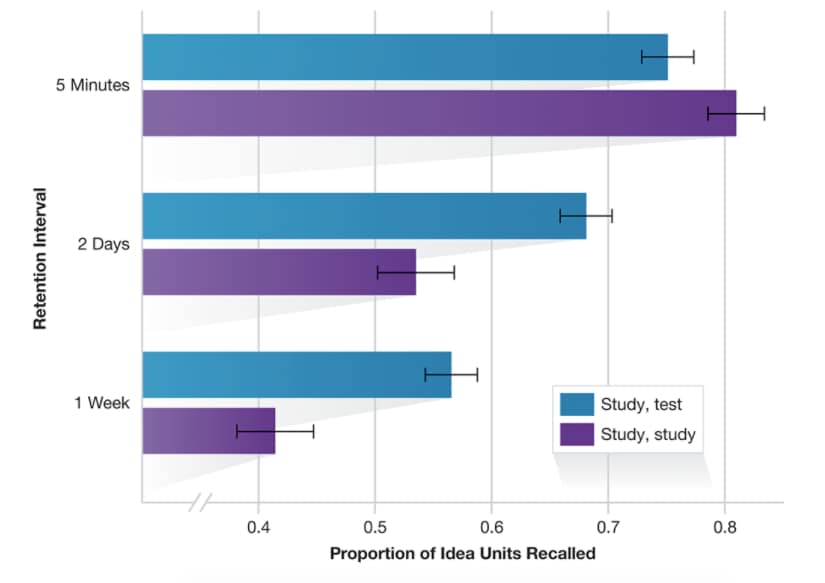Teaching Your Students Better Study Habits

What do you think is the most common way students study?
As you can see, most students choose inefficient study habits: re-reading the chapter, highlighting, or reviewing your notes. While these are popular study strategies, they are also the least effective.
Why not? What’s the proof?
In 2009, an experiment tested the effectiveness of re-reading. It found that exam scores did not significantly improve after students read a textbook chapter a second time. Another study done in 2005 found that reviewing notes, highlighting, and re-reading had no effect on students’ exam scores; in fact, the total number of hours spent studying was only weakly related to exam scores.
As an educator, you can encourage your students to develop healthy, efficient study habits and help them succeed in your course. Here are four of the top study strategies recommended by learning scientists:
1. Do practice questions
We often think about academic learning in stages that progress from the “study phase” to the “testing phase.” However, taking practice tests during the study phase has been proven to improve test performance more than additional study time.

Why does it work?
The act of taking practice tests forces students to deliberately recall information, a method called retrieval practice or the testing effect. When included in the study phase, this strategy strengthens neural patterns and significantly improves long-term memory.
Key Takeaway
Students retain information best when studying is paired with practice testing rather than spending time on study alone.
2. Study multiple topics together
Most students have been taught to study using blocked practice, reviewing a topic thoroughly before moving on. But exams have different types of problems covering multiple topics. Studying several related topics together, known as interleaving, helps students practice choosing the correct solutions to solve a problem.

Why does it work?
Interleaving teaches students to think critically about the concepts and strategies required to answer a question. Because the correct solution changes for each practice, students must retrieve knowledge and apply them to different problems, ultimately improving long-term memory.
Key Takeaway
While students may feel a sense of mastery when they get into the “groove” of repeatedly applying a set of concepts through blocked practice, the added effort of interleaving can produce better and longer-lasting results.
3. Deeply process information
When students interact with information in a shallow way, by copying vocabulary or highlighting, they only retain the information for a short amount of time.
Students will retain information longer when they use deep processing methods like drawing concept maps, creating their own exam questions, rewriting definitions in their own words, or teaching someone.
Why does it work?
Deep processing strategies are often called elaborative rehearsal because they require students to let new information sink into their brains instead of rehearsing it in a repetitive, shallow way. In elaborating on the information, students make meaningful connections which leads to better recall.
Key Takeaway
Re-reading, highlighting, and copying down definitions don’t help students deeply process information. The best way to make information stick is to engage with the material in a deeper, more meaningful way.
4. Assess current knowledge
If you ask students to predict their score before taking an exam, they will mostly likely make predictions that are higher than their actual score. Developing metacognitive skills helps students accurately assess their knowledge and study progress.
Why does it work?
Metacognition means “thinking about thinking” and helps students to be self-aware about their learning. Evidence suggests that having poor metacognitive skills can actually cause poor exam performance because students don’t choose the right study methods and don’t gauge how long they need to study for.
Key Takeaway
Metacognition helps students recognize their knowledge gaps and assess which study strategies are most effective for their situation.
The question now remains: How can you apply these strategies to your course design?
There are a range of ways you can bring these ideas into your classroom, from pop quizzes to a concept map project. Aside from creating your own activities, you can also use an eTextbook like Revel with pre-created critical thinking activities, quizzes, and interactive exercises embedded throughout. This enhanced eTextbook is an incredible resource that was designed based on decades of learning science research to help students develop these good study practices.
No matter how you choose to teach your students these study strategies, helping them develop good practices will not only benefit them throughout their university journey but also help them achieve their future goals more easily and efficiently.

Revel is a digital learning environment with a seamless blend of author-created digital text, media, and assessment based on learningscience. This fully digital, immersive educational technology boosts student engagement and retention, leading to better understanding of concepts and improved performance throughout the course. Learn more about Revel.
Find out how you can use Revel to help your students learn better